外研版英语七年级下Module 11 Body language Unit 1 They touch noses!课件(共42张ppt)
文档属性
| 名称 | 外研版英语七年级下Module 11 Body language Unit 1 They touch noses!课件(共42张ppt) | 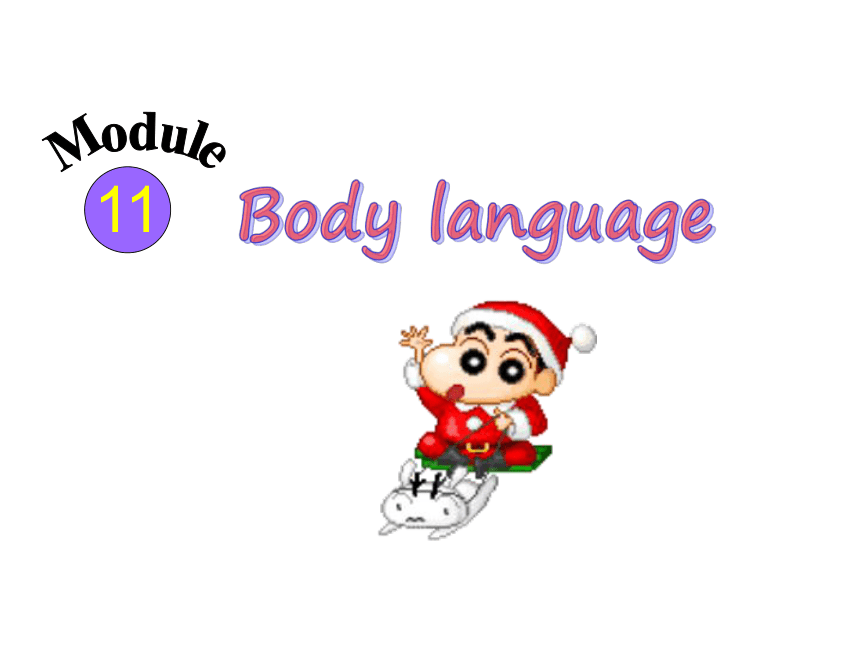 | |
| 格式 | zip | ||
| 文件大小 | 1.1MB | ||
| 资源类型 | 教案 | ||
| 版本资源 | 外研版 | ||
| 科目 | 英语 | ||
| 更新时间 | 2016-04-18 09:41:17 | ||
图片预览

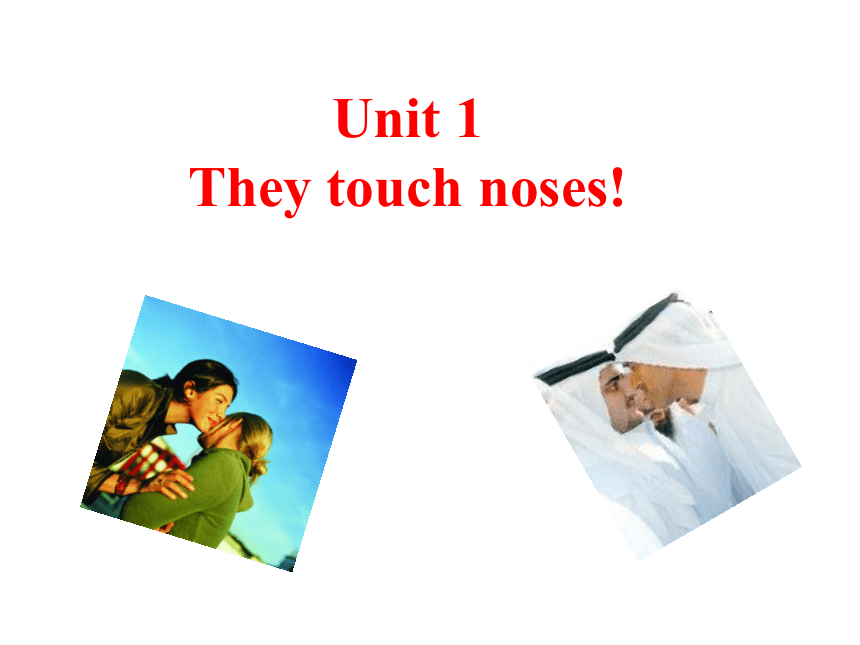
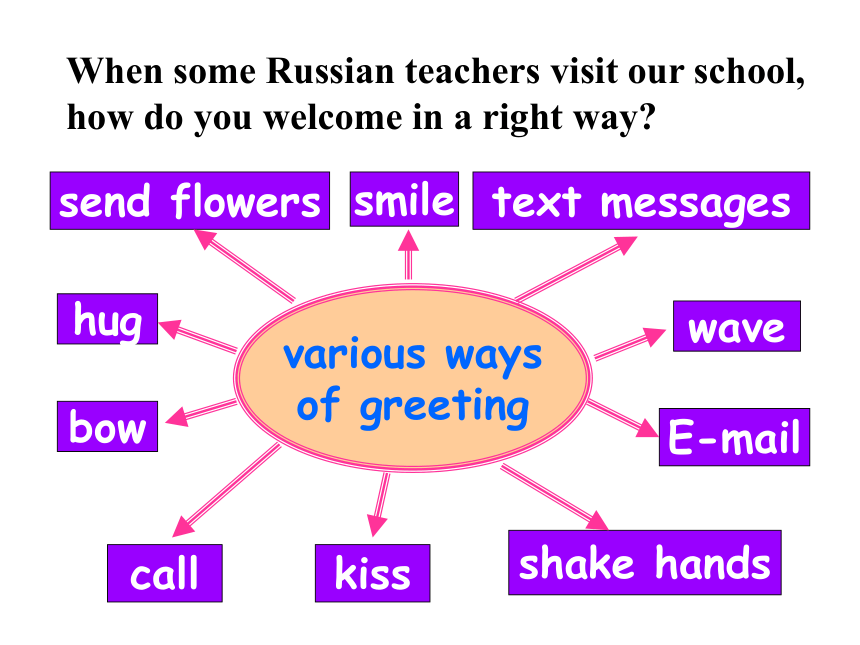


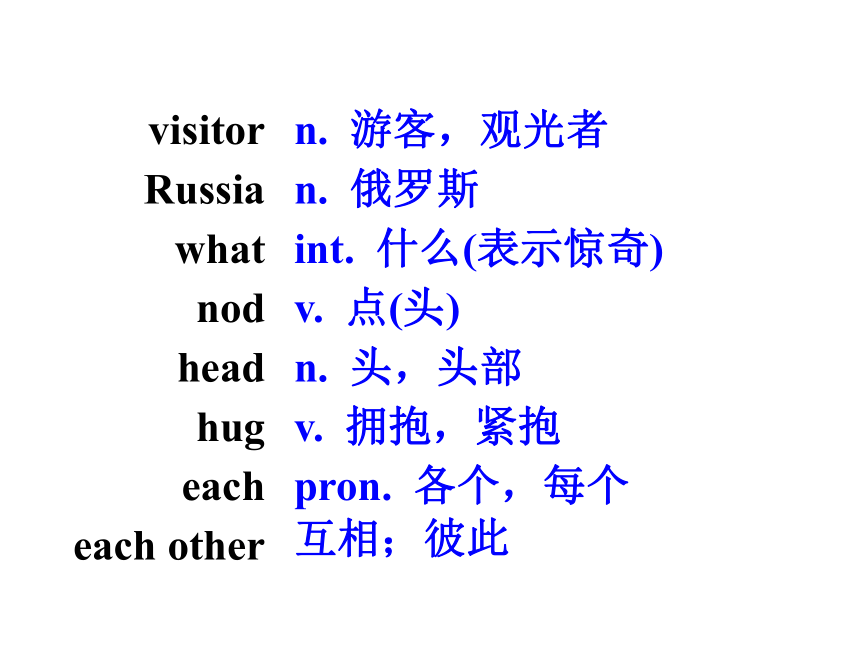

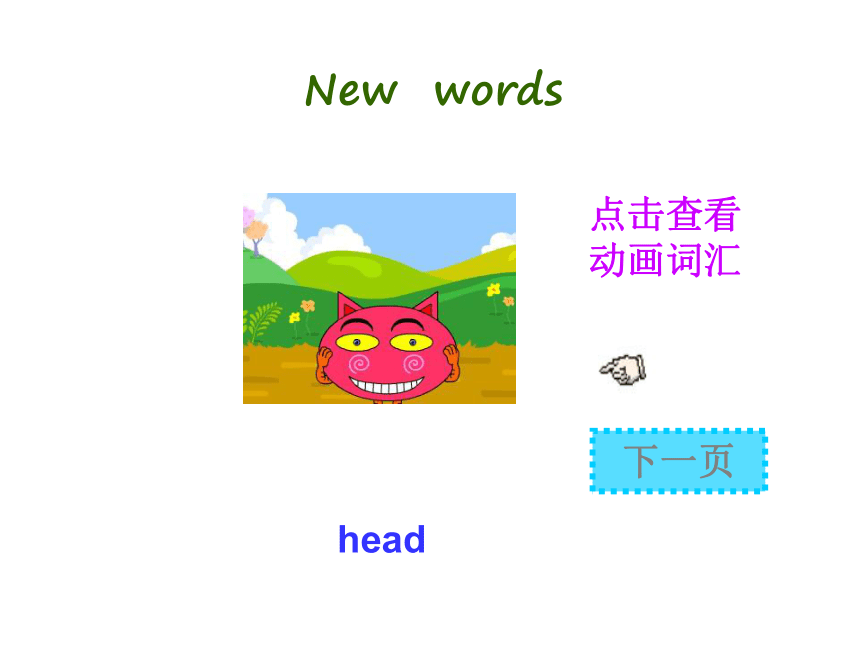

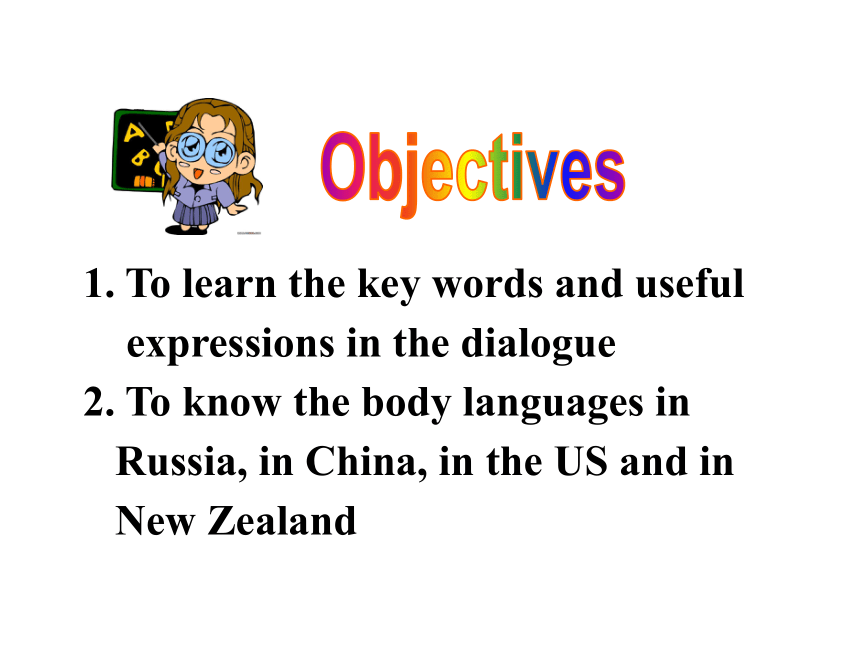
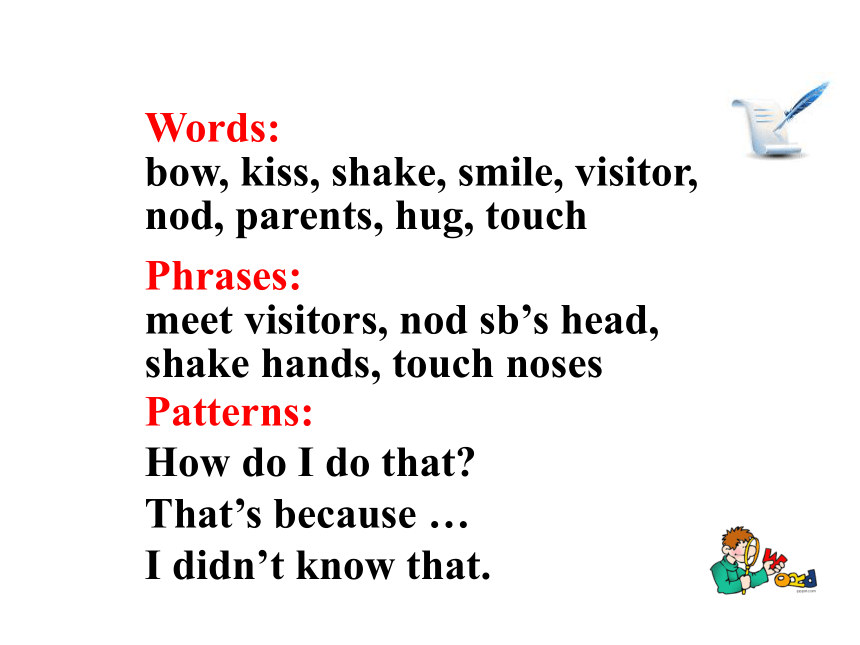
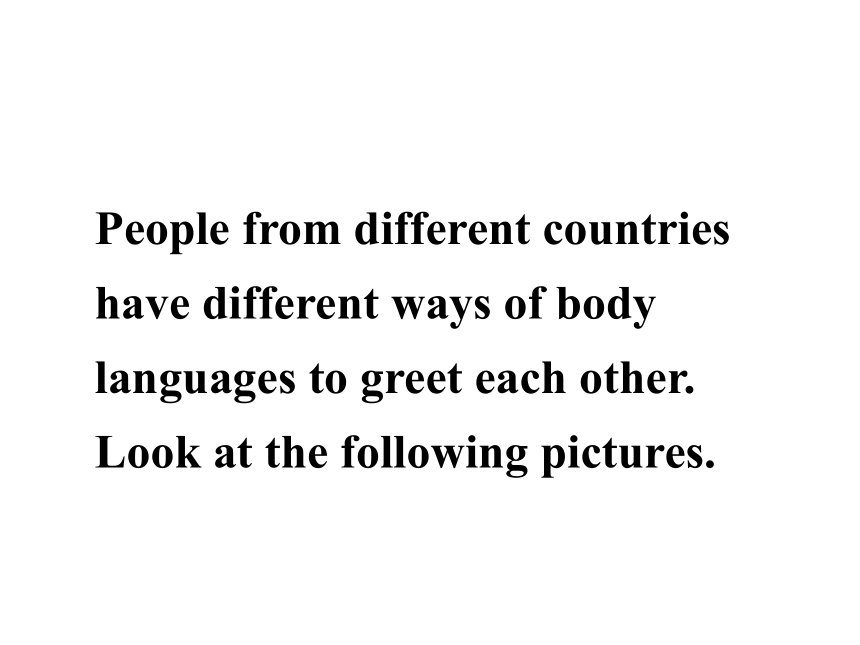
文档简介
课件42张PPT。Module11Body languageUnit 1
They touch noses!various ways
of greetingcalltext messagessmilesend flowersshake handshugwavekissE-mailbowWhen some Russian teachers visit our school, how do you welcome in a right way? ReviewWords and expressionsbow
kiss
shake
shake hands
smile
British
German
Japanese
v. 鞠躬,弯腰
v. & n. 吻,亲吻
v. 摇晃
握手
v. & n. 微笑
adj. 英国的,英国人的
n. 德国人;德语
adj. 德国(人)的;德语的
n. 日本人;日语
adj. 日本(人)的;日语的visitor
Russia
what
nod
head
hug
each
each othern. 游客,观光者
n. 俄罗斯
int. 什么(表示惊奇)
v. 点(头)
n. 头,头部
v. 拥抱,紧抱
pron. 各个,每个
互相;彼此India
together
Maori
touch
nosen. 印度
adv. 一起;共同
adj. 毛利人的
v. 触摸;接触
n. 鼻子New words 点击查看
动画词汇head下一页New words 点击查看
动画词汇nose下一页1. To learn the key words and useful
expressions in the dialogue
2. To know the body languages in Russia, in China, in the US and in New ZealandObjectivesWords:
bow, kiss, shake, smile, visitor, nod, parents, hug, touchPhrases:
meet visitors, nod sb’s head, shake hands, touch noses Patterns:
How do I do that?
That’s because …
I didn’t know that.People from different countries have different ways of body languages to greet each other. Look at the following pictures. Chinese wayShake hands and smileRussian wayKiss three timesAmerican wayShake hands, kiss or hugIndian wayPut hands together and nod headsMaori peopleTouch nosesListening and vocabularyMatch the pictures with the words and expression from the box.bow ( ) kiss ( )
shake hands ( ) smile ( )Listen and match the pictures with the nationality.British ( ) French ( )
German ( ) Japanese ( )
Russian ( )Now work in pairs and check.
— Are they Russian?
— Yes, they are.
— What are they doing?
— They’re shaking hands.Listen and read点击查看
下一页Listen and read the dialogue on Page 66.Lingling: We’re going to have some Russian teachers at school tomorrow, and I’m
welcoming the visitors. How do I do that?
Betty: Lingling, you know, in Russia, people usually kiss three times, left, right, left.
Lingling: What! No, I didn’t know that. We Chinese often shake hands and smile when we meet visitors, and sometimes we nod our heads. But we never kiss. Only parents and children do that. ?Betty: That’s because people do different things in different countries.
Lingling: So what do people in the US usually do when they meet?
Betty: In the US some people shake hands, and some kiss or hug each other. In
India people put their hands together and nod their heads. And do you know what Maori people in New Zealand do when they meet?
Lingling: No. What do they do?
Betty: They touch noses! Language points1. … in Russia, people usually kiss three times, left, right, left.
……在俄罗斯,人们通常亲吻三次,左、右、左。
kiss v. 吻,亲吻
The mother kissed the sleeping baby on his head.
kiss n. 吻
He threw me a kiss and went away.2. That’s because people do different things in different countries.
那是因为不同国家的人们做法不同。
that’s because …是一个常用句式,表示 “那是因为……”,例如:
That’s because you were not careful enough.
那是因为你不够仔细。
That’s because I didn’t know much about body language in this country.
那是因为我对这个国家的肢体语言了解不够。3. They touch noses!
他们互相碰鼻子! 碰鼻礼是毛利人传统的打招呼方式,也是一种表达真挚问候的礼仪。行礼时,相互问候的两个人要鼻尖相碰,表示交换双方的呼吸,使之融合在一起。毛利人是新西兰的原住民,他们有自己独特的生活方式和文化。Answer the questions about the dialogue.
What do Russian do when they meet?
People in Russia usually kiss three times,
left, right, left.
2. What do Chinese do when they meet?
Chinese often shake hands and smile
when they meet.3. What do people in the US usually do
when they meet?
In the US some people shake hands, and some kiss or hug each other.
What do Maori people do when they
meet?
They touch noses.Now complete the table with the correct form of the words from the box.India, kiss, Russia
together, touch, visitorIn China, people shake hands and smile American people shake hands and sometimes (1) _______when they meet (6) ________kissvisitorIn (2) _______, people put their hands (3) _________
In (4) ________, people kiss each other 3 times
Maori people (5) ________ noseswhen they meet (6) ________India togetherRussia touchvisitorPronunciation and speakingListen and repeat./t?/ Chinese, each, French, teacher,
touch/?/ British, shake
/pl/ people
/fr/ French
/br/ BritishWork in groups. Talk about what you do and say when you meet: your teacher
your head teacher
your parents after school
your best friend
your best friend’s parents
your favourite film star a visitor to your school
an American
a Russian— What do you do and say when you
meet your teacher in the morning?
— I smile and say good morning.ExerciseI. 根据首字母及句子意思,填入恰当的词。1. “Welcome!”, she s_____ hands and smiles.
2. She came and gave her grandpa’s a h__.
3. If you agree my ideas, you n__ your head.
4. Maori people in New Zealand t____ noses when they meet.
5. They b__ to their king every morning. hakes ug od ouch owII. 根据今天所学内容,完成短文。In _____, people shake hands and smile when they meet visitors. In ______________, people shake hand and sometimes kiss. In _____, people put their hand together and nod their heads. In ______, people usually kiss three times, In ___________, Maori people touch noses. China America/the US India Russia New Zealand HomeworkWrite a short passage about the greeting ways in China.
They touch noses!various ways
of greetingcalltext messagessmilesend flowersshake handshugwavekissE-mailbowWhen some Russian teachers visit our school, how do you welcome in a right way? ReviewWords and expressionsbow
kiss
shake
shake hands
smile
British
German
Japanese
v. 鞠躬,弯腰
v. & n. 吻,亲吻
v. 摇晃
握手
v. & n. 微笑
adj. 英国的,英国人的
n. 德国人;德语
adj. 德国(人)的;德语的
n. 日本人;日语
adj. 日本(人)的;日语的visitor
Russia
what
nod
head
hug
each
each othern. 游客,观光者
n. 俄罗斯
int. 什么(表示惊奇)
v. 点(头)
n. 头,头部
v. 拥抱,紧抱
pron. 各个,每个
互相;彼此India
together
Maori
touch
nosen. 印度
adv. 一起;共同
adj. 毛利人的
v. 触摸;接触
n. 鼻子New words 点击查看
动画词汇head下一页New words 点击查看
动画词汇nose下一页1. To learn the key words and useful
expressions in the dialogue
2. To know the body languages in Russia, in China, in the US and in New ZealandObjectivesWords:
bow, kiss, shake, smile, visitor, nod, parents, hug, touchPhrases:
meet visitors, nod sb’s head, shake hands, touch noses Patterns:
How do I do that?
That’s because …
I didn’t know that.People from different countries have different ways of body languages to greet each other. Look at the following pictures. Chinese wayShake hands and smileRussian wayKiss three timesAmerican wayShake hands, kiss or hugIndian wayPut hands together and nod headsMaori peopleTouch nosesListening and vocabularyMatch the pictures with the words and expression from the box.bow ( ) kiss ( )
shake hands ( ) smile ( )Listen and match the pictures with the nationality.British ( ) French ( )
German ( ) Japanese ( )
Russian ( )Now work in pairs and check.
— Are they Russian?
— Yes, they are.
— What are they doing?
— They’re shaking hands.Listen and read点击查看
下一页Listen and read the dialogue on Page 66.Lingling: We’re going to have some Russian teachers at school tomorrow, and I’m
welcoming the visitors. How do I do that?
Betty: Lingling, you know, in Russia, people usually kiss three times, left, right, left.
Lingling: What! No, I didn’t know that. We Chinese often shake hands and smile when we meet visitors, and sometimes we nod our heads. But we never kiss. Only parents and children do that. ?Betty: That’s because people do different things in different countries.
Lingling: So what do people in the US usually do when they meet?
Betty: In the US some people shake hands, and some kiss or hug each other. In
India people put their hands together and nod their heads. And do you know what Maori people in New Zealand do when they meet?
Lingling: No. What do they do?
Betty: They touch noses! Language points1. … in Russia, people usually kiss three times, left, right, left.
……在俄罗斯,人们通常亲吻三次,左、右、左。
kiss v. 吻,亲吻
The mother kissed the sleeping baby on his head.
kiss n. 吻
He threw me a kiss and went away.2. That’s because people do different things in different countries.
那是因为不同国家的人们做法不同。
that’s because …是一个常用句式,表示 “那是因为……”,例如:
That’s because you were not careful enough.
那是因为你不够仔细。
That’s because I didn’t know much about body language in this country.
那是因为我对这个国家的肢体语言了解不够。3. They touch noses!
他们互相碰鼻子! 碰鼻礼是毛利人传统的打招呼方式,也是一种表达真挚问候的礼仪。行礼时,相互问候的两个人要鼻尖相碰,表示交换双方的呼吸,使之融合在一起。毛利人是新西兰的原住民,他们有自己独特的生活方式和文化。Answer the questions about the dialogue.
What do Russian do when they meet?
People in Russia usually kiss three times,
left, right, left.
2. What do Chinese do when they meet?
Chinese often shake hands and smile
when they meet.3. What do people in the US usually do
when they meet?
In the US some people shake hands, and some kiss or hug each other.
What do Maori people do when they
meet?
They touch noses.Now complete the table with the correct form of the words from the box.India, kiss, Russia
together, touch, visitorIn China, people shake hands and smile American people shake hands and sometimes (1) _______when they meet (6) ________kissvisitorIn (2) _______, people put their hands (3) _________
In (4) ________, people kiss each other 3 times
Maori people (5) ________ noseswhen they meet (6) ________India togetherRussia touchvisitorPronunciation and speakingListen and repeat./t?/ Chinese, each, French, teacher,
touch/?/ British, shake
/pl/ people
/fr/ French
/br/ BritishWork in groups. Talk about what you do and say when you meet: your teacher
your head teacher
your parents after school
your best friend
your best friend’s parents
your favourite film star a visitor to your school
an American
a Russian— What do you do and say when you
meet your teacher in the morning?
— I smile and say good morning.ExerciseI. 根据首字母及句子意思,填入恰当的词。1. “Welcome!”, she s_____ hands and smiles.
2. She came and gave her grandpa’s a h__.
3. If you agree my ideas, you n__ your head.
4. Maori people in New Zealand t____ noses when they meet.
5. They b__ to their king every morning. hakes ug od ouch owII. 根据今天所学内容,完成短文。In _____, people shake hands and smile when they meet visitors. In ______________, people shake hand and sometimes kiss. In _____, people put their hand together and nod their heads. In ______, people usually kiss three times, In ___________, Maori people touch noses. China America/the US India Russia New Zealand HomeworkWrite a short passage about the greeting ways in China.
同课章节目录
- Module 1 Lost and found
- Unit 1 Whose bag is this?
- Unit 2 Are they yours?
- Unit 3 Language in use
- Module 2 What can you do ?
- Unit 1 I can play the piano
- Unit 2 I can run really fast
- Unit 3 Language in use
- Module 3 Making plans
- Unit 1 What are you going to do at the weekends?
- Unit 2 We're going to cheer the players.
- Unit 3 Language in use
- Module 4 Life in the future
- Unit 1 Everyone will study at home
- Unit 2 Every family will have a small plane.
- Unit 3 Language in use
- Module 5 Shopping
- Unit 1 What can I do for you?
- Unit 2 You can buy everything on the Internet
- Unit 3 Language in use
- Module 6 Around town
- Unit 1 Could you tell me how to get to the Nationa
- Unit 2 The London Eye is on your right.
- Unit 3 Language in use
- Revision module A
- Module 7 My past life
- Unit 1 I was born in a small village.
- Unit 2 I was born in Quincy.
- Unit 3 Language in use
- Module 8 Story time
- Unit 1 Once upon a time….
- Unit 2 Goldilocks hurried out of the house.
- Unit 3 Language in use
- Module 9 Life history
- Unit 1 He left school and began work at the age of
- Unit 2 He decided to be an actor.
- Unit 3 Language in use
- Module 10 A holiday journey
- Unit 1 What did you do?
- Unit 2 This morning we took a walk.
- Unit 3 Language in use
- Module 11 Body language
- Unit 1 They touch noses!
- Unit 2 Here are some ways to welcome them.
- Unit 3 Language in use
- Module 12 Western music
- Unit 1 It's so beautiful!
- Unit 2 Vienna is the centre of European classical
- Unit 3 Language in use
- Revision module B
